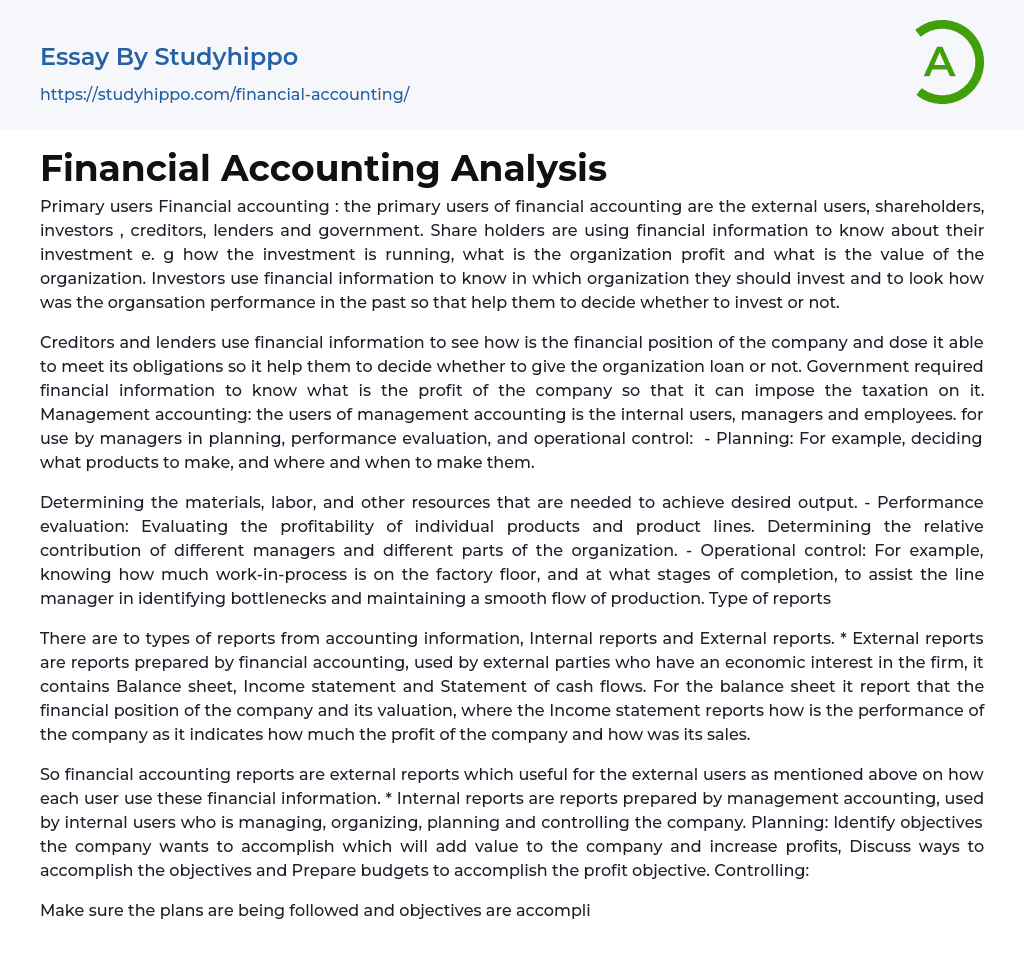The primary users of financial accounting are external users such as shareholders, investors, creditors, lenders, and the government. Shareholders utilize financial information to track their investments, assess organizational profitability, and determine the value of the organization. Investors rely on financial information to guide their investment decisions and evaluate past organizational performance to decide whether to invest or not.
Financial information is important for creditors, lenders, and government authorities as it helps evaluate a company's financial position and ability to meet its obligations. This data is crucial in determining whether to provide loans or impose taxes based on the organization's profits. On the other hand, management accounting focuses on assisting internal users such as managers and employees. It supports managers in areas like planning, performance evaluation, and operational control. For instance, it aids in decision-making regarding product manufacturing,
...timing, and location.
The text discusses three key elements of management control: resource planning, performance evaluation, and operational control. Resource planning entails determining the required materials, labor, and other resources to achieve the desired output. Performance evaluation involves assessing the profitability of individual products and product lines, as well as analyzing the contributions of different managers and sections within the organization. Operational control focuses on monitoring work-in-process on the factory floor to identify bottlenecks and ensure a seamless production flow. These aspects are vital in management and are reflected in diverse report types.
Accounting involves two types of reports: Internal and External. External reports, generated by financial accounting, are used by external stakeholders with a financial interest in the company. These reports typically include a Balance sheet, Income statement, and Statement of cash flows. The Balance shee
provides information about the company's financial standing and worth, while the Income statement showcases its performance through profit and sales numbers.
Financial accounting reports are external reports that provide useful information to external users regarding the usage of financial information. On the other hand, internal reports are prepared by management accounting for internal users involved in managing, organizing, planning, and controlling the company. These internal reports help with planning objectives that add value and increase profits, discussing strategies to achieve these objectives, and creating budgets for profit attainment. In terms of controlling the company's operations,
Ensure that the plans are being executed and goals are being achieved. Compare actual results to the budget to report on performance and make necessary changes when objectives are not being met. Use all available information to make informed business decisions. Financial accounts focus on the overall business rather than analyzing individual components. For instance, sales figures are combined to provide a total sales figure instead of a detailed breakdown by product.
Financial accounting only provides the total amount figure and does not analyze each transaction in detail. In contrast, management accounts concentrate on specific areas of a business, such as the performance of products (including cost, selling price, and production schedule) and departments/divisions (including interdepartmental relationships and activities). These distinctions serve various purposes.
Financial accounts provide information on a business's performance and state of affairs during a specified period, commonly referred to as the "Trading Period," typically lasting one year. The period-end date is known as the "Balance Sheet Date." On the other hand, management accounts aid in recording, planning, and controlling business activities, serving as a tool for
decision-making. These accounts can be prepared for any period, such as daily reports for retailers regarding sales, margins, and stock levels. The scope of information includes both financial and management aspects.
- Accounts Receivable essays
- Auditor's Report essays
- Balance Sheet essays
- Costs essays
- Financial Audit essays
- International Financial Reporting Standards essays
- Tax essays
- Accountability essays
- Cash essays
- Principal essays
- Management Accounting essays
- Internal Control essays
- Accounting Software essays
- Cash Flow essays
- Net Present Value essays
- Income Statement essays
- Investing essays
- Asset essays
- Depreciation essays
- Discounted Cash Flow essays
- Foreign Direct Investment essays
- Funds essays
- Internal Rate Of Return essays
- Revenue essays
- Day Trading essays
- Futures Trading essays
- Capital market essays
- Million essays
- Payment essays
- Rate Of Return essays
- Funding essays
- Hedge Fund essays
- Accounting essays
- Andrew Carnegie essays
- Automation essays
- Business Cycle essays
- Business Intelligence essays
- Business Model essays
- Business Operations essays
- Business Software essays
- Cooperation essays
- Cooperative essays
- Corporate Social Responsibility essays
- Corporation essays
- Customer Relationship Management essays
- Family Business essays
- Franchising essays
- Harvard Business School essays
- Harvard university essays
- Human Resource Management essays




